
- •Introduction to the Anchor Handling Course
- •Technical Specifications:
- •Winch Layout:
- •Power Settings / Bollard Pull
- •All operations on board must be performed in accordance with Company Procedures.
- •Risk Assessment
- •Planning
- •Planning:
- •Goal, example:
- •What to do:
- •Electrical winches
- •Winch operation
- •General Arrangement
- •A/H-Drum at full Capacity
- •Over speed
- •Water brake
- •Band brake
- •QUICK & Full Release
- •Hydraulic Winches
- •Lay out (B-type)
- •Hydraulic winch, “B-type”
- •TOWCON
- •Instruction for use of Wire Drums
- •Changing of Chain Wheels (Wildcats / Chain Lifter)
- •TRIPLEX - SHARK JAW SYSTEM.
- •Operation
- •Maintenance and inspections
- •Safety
- •2. OPERATION:
- •QUICK RELEASE:
- •EMERGENCY RELEASE:
- •CONTROL PANEL
- •Marks for Locked on Hinge Link
- •2.2- OPERATION OF THE "JAW IN POSITION ACCEPT" LEVER:
- •2.3 OPERATION OF THE CONTROL PANEL AT EMERGENCY POWER.
- •3. ELECTRIC AND HYDRAULIC POWER SYSTEM.
- •3. 1. ARRANGEMENT OF SYSTEM.
- •3.2. FUNCTIONING OF QUICK RELEASE - JAWS ONLY.
- •3.3. FUNCTIONING OF EMERGENCY RELEASE
- •4.2 Test without Load.
- •4.3 Test with Load.
- •5. General Maintenance
- •5.1 Accumulators Depressurising
- •5.2 Shark Jaw Unit
- •5.3 Guide Pins Units
- •5.4 Hydraulic System
- •5.5 Electric System
- •6. Control Measurements / Adjustments.
- •6.2 Adjustment of inductive proximity switches on lock cylinders.
- •6.3 Adjustment of Pressure Switches for Lock Pressure.
- •7. Test Program – Periodical Control
- •7.2 Checking List – Periodic Control Mechanical / Hydraulic.
- •7.3 Checking List – Periodic Control Electrical
- •7.4 Testing without Load – Yearly Testing.
- •7.5 Load Test – Emergency Release – 5 Year Control.
- •“Mark on line !”
- •“Double set of Jaws, Pins and Wire lifter”
- •View from the bridge.
- •“JAW READY FOR OPERATION”
- •“JAW LOCK POSITION ACCEPTED”
- •KARM FORK – SHARK JAW SYSTEM.
- •Wire and chain Stopper
- •Inserts for KARM FORK
- •Martensite:
- •Recommendations:
- •1. THE BASIC ELEMENTS OF STEEL WIRE ROPE
- •2. STEEL WIRE ROPE CONSTRUCTIONS
- •3. SPECIAL STEEL WIRE ROPES
- •4. USE OF STEEL WIRE ROPE
- •5. SELECTING THE RIGHT STEEL WIRE ROPE
- •6. ORDERING STEEL WIRE ROPE
- •7. STEEL WIRE ROPE TOLERANCES
- •8. HANDLING, INSPECTION AND INSTALLATION
- •9. INSPECTION AND MAINTENANCE
- •10. ELONGATION AND PRE-STRETCHING
- •11. OPERATING TEMPERATURES
- •12. MARTENSITE FORMATION
- •13. END TERMINATIONS
- •14. SOCKETING (WIRELOCK)
- •15. DRUM CAPACITY
- •16. CLASSIFICATION AND USE OF STEEL WIRE ROPE
- •17. ROPES
- •18. CHAINS AND LIFTING COMPONENTS
- •19. TECHNICAL CONVERSION TABLES
- •SWIVEL
- •MoorLink Swivel
- •Pin Extractor
- •Socket Bench
- •Chains and Fittings
- •STUD LINK MOORING CHAIN
- •OPEN LINK MOORING CHAIN
- •KENTER JOINING LINKS
- •PEAR SHAPE ANCHOR CONNECTING LINK
- •DETACHABLE CONNECTING LINK
- •D’ TYPE JOINING SHACKLES
- •‘D’ TYPE ANCHOR SHACKLES
- •SHACKLES
- •JAW & JAW SWIVELS
- •BOW & EYE SWIVELS
- •MOORING RINGS
- •FISH PLATES
- •PELICAN HOOKS
- •SLIP HOOKS
- •‘J’ CHASERS
- •PERMANENT CHASERS
- •DETACHABLE PERMANENT CHAIN CHASERS
- •PERMANENT WIRE CHASERS
- •‘J’ LOCK CHAIN CHASERS
- •The way to break the anchor loose of the bottom is therefore:
- •Table of contents
- •Introduction
- •General
- •Mooring systems
- •Mooring components
- •History of drag embedment anchors
- •Characteristics of anchor types
- •History of vryhof anchor designs
- •Criteria for anchor holding capacity
- •Theory
- •Criteria for good anchor design
- •Aspects of soil mechanics in anchor design
- •Soil classification
- •Fluke/shank angle
- •Fluke area
- •Strength of an anchor design
- •Anchor loads and safety factors
- •Anchor behaviour in the soil
- •Proof loads for high holding power anchors
- •Anchor tests
- •Soil table
- •Practice
- •Introduction
- •Soil survey
- •Pile or anchor
- •Setting the fluke/shank angle
- •Connecting a swivel to the Stevpris anchor
- •Chasers
- •Chaser types
- •Stevpris installation
- •Laying anchors
- •Retrieving anchors
- •Anchor orientation
- •Decking the Stevpris anchor
- •What not to do!
- •Racking the Stevpris
- •Deploying Stevpris from the anchor rack
- •Boarding the anchor in deep water
- •Ballast In fluke
- •Chaser equilibrium
- •Deployment for permanent moorings
- •Piggy-backing
- •Piggy-back methods
- •Stevmanta VLA installation
- •Installation procedure
- •Stevmanta retrieval
- •Double line installation procedure
- •Stevmanta retrieval
- •Double line installation with Stevtensioner
- •The Stevtensioner
- •The working principle of the tensioner
- •Measurement of the tensions applied
- •Umbilical cable and measuring pin
- •Break - link
- •Duration of pretensioning anchors and piles
- •Handling the Stevtensioner
- •General tensioning procedures
- •Hook-up
- •Lowering
- •Tensioning mode
- •Retrieving
- •Supply vessels/anchor handling vessels
- •Product data
- •Introduction
- •Dimensions of vryhof anchor types
- •Proof load test for HHP anchors (US units)
- •Dimensions of vryhof tensioners
- •Proof load/break load of chains (in US units)
- •Chain components and forerunners
- •Connecting links
- •Conversion table
- •Mooring line catenary
- •Mooring line holding capacity
- •Shackles
- •Wire Rope
- •Wire rope sockets
- •Thimbles
- •Synthetic ropes
- •Mooring hawsers
- •Main dimensions chasers
- •Stevin Mk3 UHC chart
- •Stevin Mk3 drag and penetration chart
- •Stevpris Mk5 UHC chart
- •Stevpris Mk5 drag and penetration chart
- •Stevmanta VLA UPC chart
- •Introduction
- •Propulsion system
- •Propellers
- •Thrusters
- •Rudders
- •Manoeuvring
- •Current
- •Wind
- •Other forces
- •Turning point (Pivot point)
- •Ship handling
- •General layout Jack-Up drilling unit:
- •General information about a Semi Submersible drilling unit:
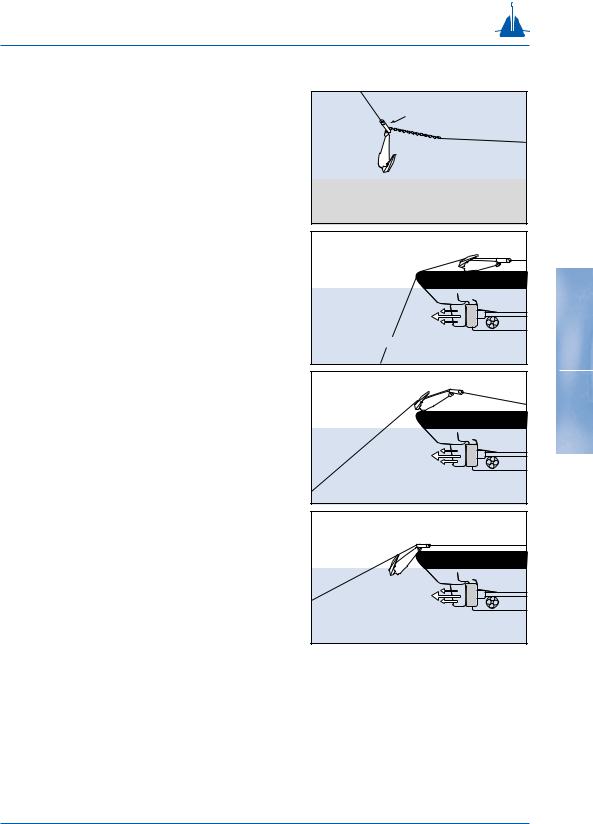
Stevpris installation
Stevpris deployment for MODUs
Introduction
Typical methods for deployment and retrieval of Stevpris anchors with an anchor handling vessel (AHV) are described, focusing on the use of chasers for handling the anchor (fig. 3-20). This is the most common practice on mobile drilling rigs (MODUs). Handling using permanent pendant lines is similar.
Deployment procedures for the Stevpris anchor will also be given for permanent moorings where chasers are normally not used.
Laying anchors
It is preferred, and by some operators required, to deck the anchor before run out to check the jewellery. Run the anchor line out the full distance with anchor on deck or on roller, with the chain between the flukes (fig. 3-21).
Boat increases power until anchor line tension rises on rig winch tension meter. When rig gives order to lower the anchor, veer pendant till anchor arrives at roller. Allow the anchor some speed to negotiate the bump at the change-over from the deck on to the roller
(fig. 3-22).
If anchor is kept on roller, keep triangular plates below the main shackle on the drum for stability of the anchor. Alternatively the chaser can be kept on deck/roller. In this situation the propeller thrust passes underneath the anchor and does not influence the fluke (fig. 3-23).
chaser
fig. 3-20 |
always deck anchor with chain between flukes |
fig. 3-21 |
63 |
quickly pass drum |
fig. 3-22 |
triangular plates on drum |
fig. 3-23 |
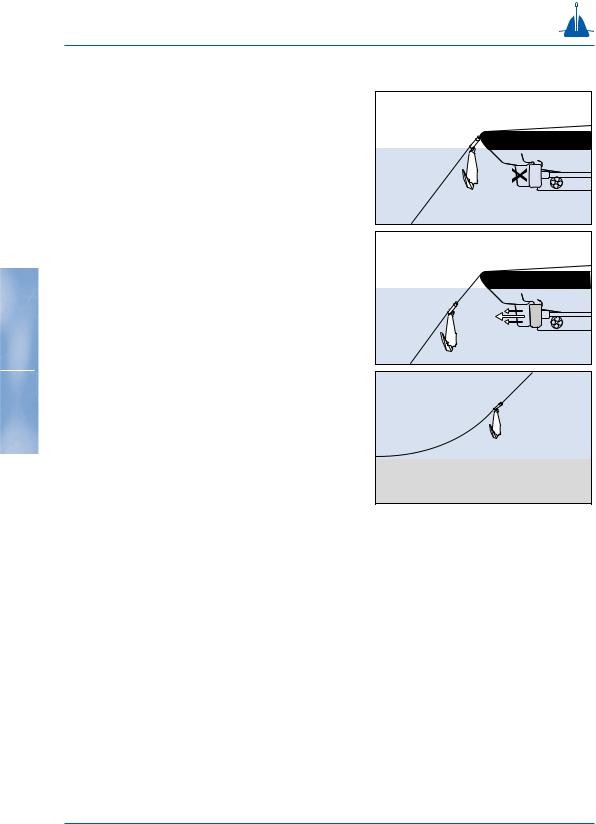
Stevpris installation
Reduce propulsion momentarily when anchor passes the propeller thrust, keep chaser on anchor head for control of anchor orientation and lower anchor
(fig. 3-24).
Once below the propeller wash zone, reactivate and maintain propeller thrust to well above 30 tons. Keep constant tension in order to ensure anchor does not fall through chaser, i.e. anchor remains in the chaser and orientation of the anchor is correct (fig. 3-25).
Note: In some circumstances AHVs prefer to run the anchor hanging from the pendant line below the propeller wash approximately 60 to 80 meter above the seabed. This method requires less power on the winch during the actual laying of the anchor. If this method is employed, make sure that at all times the
64anchor is correctly oriented in the chaser. Keep constant tension in the pendant line to prevent the
anchor from falling through the chaser and possibly turn.
Stop lowering when anchor hangs 10 to 15 meter above the bottom and advise rig. Rig now instructs AHV to pay out until pendant line is 1.4 to 1.5 times the water depth in shallow water (100m) and 1.3 to 1.4 times in deeper water. AHV increases power till tension is again seen to rise at the rig, i.e. the load in the line is larger than the chain-soil friction (fig. 3-26).
Rig commences to pull in slowly. AHV further increases power until tension rises further at rig winch. At this moment rig orders AHV to lay the anchor. AHV immediately stops the propulsion and is consequently pulled backwards. AHV pays out pendant and maintains paying out pendant after anchor has landed on the bottom till a wire length of 1.5 to 2 times the water depth is out. Enough slack wire must be paid out not to disturb the anchor during buoying off or waiting. Stay above or behind the anchor. Rig continues heaving the cable to a sufficient load, equal to the total chain/soil friction plus 50 t to embed the anchor fully and create confidence in good setting.
STOP |
fig. 3-24 |
fig. 3-25 |
wait for signal rig
fig. 3-26
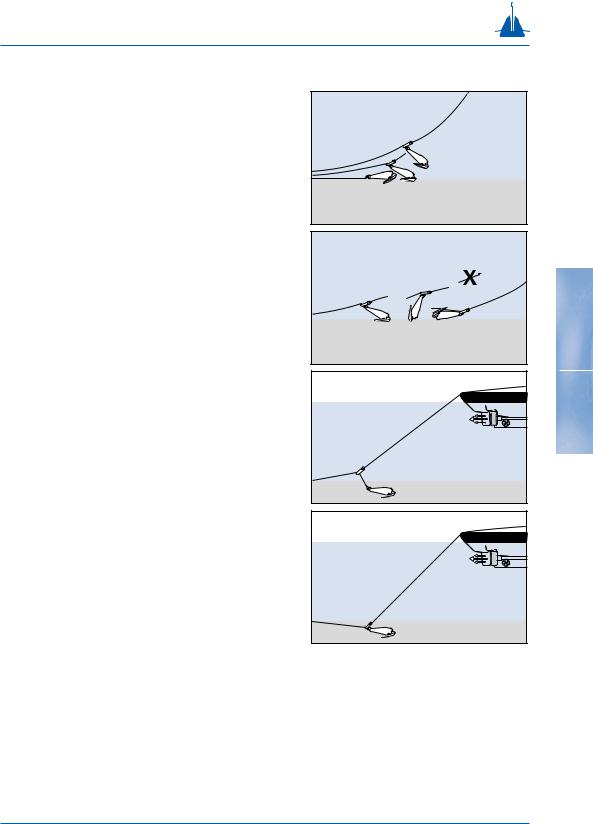
Stevpris installation
This also gives stability to the anchor when the AHV strips the chaser back or buoys off the pendant. Now the AHV can retrieve the chaser and return to the rig. If circumstances allow, the rig can tension up to the full pretension load directly (fig. 3-27).
No extra pull after landing!
It is customary with older anchors such as Danforth, Moorfast, etc. to give another pull once the anchor is on bottom. Do not do this with Stevpris anchors.
Once the anchor hits bottom, AHV should not pull again. Pendant line must remain slack, otherwise anchor could land upside down! (fig. 3-28).
Suggestion: pre-load the anchors to the maximum required pretension load as soon as the chaser is 100 meter or more ahead of the anchor, i.e. do not wait. If anchor has not been laid correctly, a rerun can be made immediately.
Retrieving anchors
The chaser should be brought to the anchor with a pendant of at least the length of 1.5 to 2 times the water depth, measured from the stern roller. Chaser should hang freely down from the anchor line till the bottom is reached, i.e. slack in the pendant line. A too short pendant and/or too little tension in the cable results in a situation as sketched (fig. 3-29).
While chasing, the rig should maintain tension of 60 to 70% of the pre-load tension. No tension in pendant to ensure smooth passing over the chain. When chaser is pulled into contact with anchor shank, increase thrust and keep thrust while heaving, especially in rough water (fig. 3-30).
rig hauls AHV slacks
fig. 3-27
do not pull after landing !
fig. 3-28
65
wrong ! keep cable under tension
fig. 3-29
patience in very soft soils !
fig. 3-30
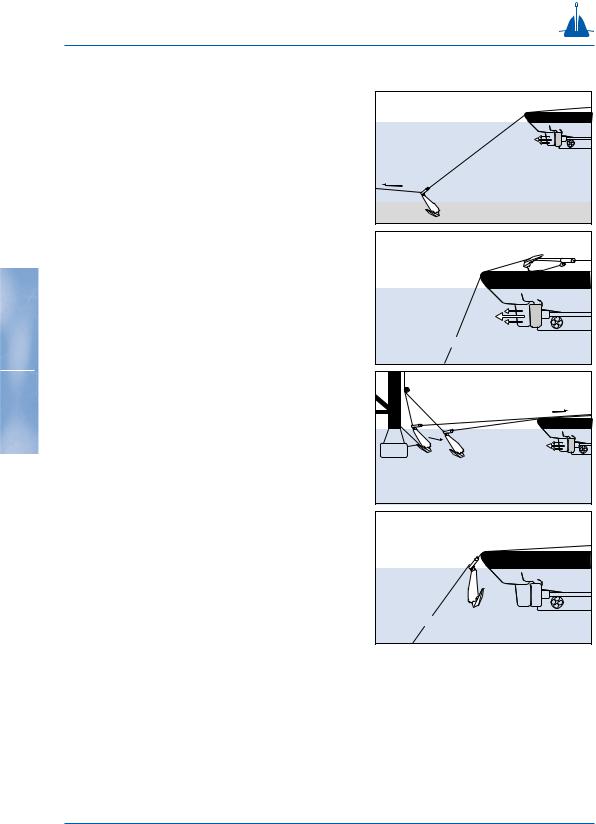
Stevpris installation
The motion of the vessel itself now helps gradually to break the anchor loose. Sequentially with the vessels motion the pendant is shortened gradually. Anchors in very soft clay can be buried very deep. Have patience, take your time and be gentle with the equipment; the anchor will come. The rig can help and speed-up the operation by hauling the anchor line at the same time! Once the anchor is off bottom, keep the chaser in contact with the bow shackle by maintaining sufficient thrust (fig. 3-31).
Anchor orientation
The anchor flukes are always oriented towards the rig, on deck the anchor lays on its back with shackle towards AHVs bow and cable between the upwards directed fluke points. Check jewelry (fig. 3-32).
66
It is important to control the anchor orientation at all times for easy racking, laying and decking of the anchor, i.e. keep pendant line under tension while working the anchor. If the anchor slides through the chaser, the anchor has to be pulled back to the stern roller and orientation checked (fig. 3-33).
Decking the Stevpris anchor
If anchor is not correctly oriented, reduce propulsion and let anchor slide down through the chaser. Rotation is easier while near the rig where all loads are lower (fig. 3-34).
|
keep |
rig |
pulling |
|
|
hauls |
|
fig. 3-31 |
|
always deck anchor with chain between flukes |
fig. 3-32 |
keep tension ! |
fig. 3-33 |
wrong ! anchor cannot deck ! |
fig. 3-34 |
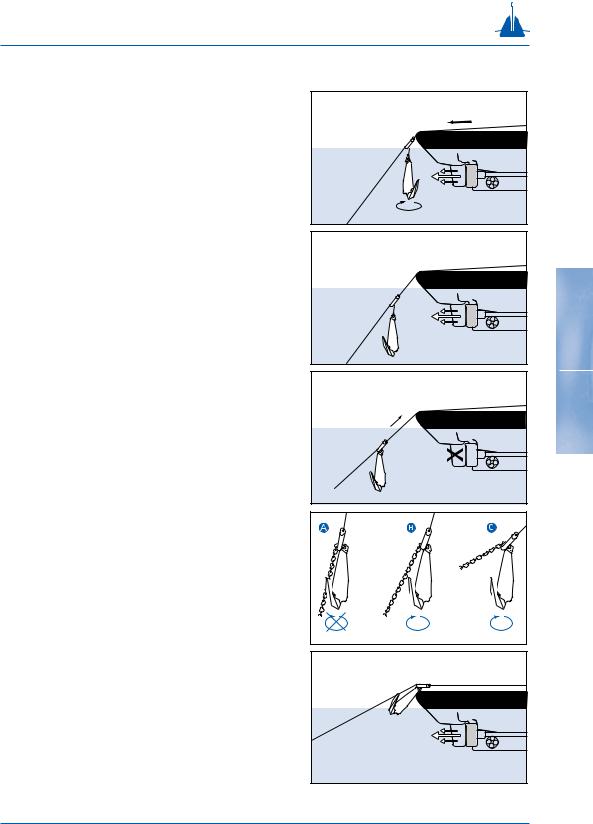
Stevpris installation
Turn the anchor with a shot of propeller wash. Then pay out pendant, make sure anchor is below the propeller wash away from the propeller influence zone
(fig. 3-35).
Increase propulsion moving AHV forward pulling chaser in contact with the anchor. Make sure the stern roller is perpendicular to the chain, the chain directing between the fluke points (fig. 3-36).
With sufficient bollard pull haul pendant, stop/reduce thrust for only a few seconds when anchor passes the propeller wash onto the drum. Pull anchor on the drum, allow the anchor to turn with its back on the roller, fluke points up. Then pull further on deck (fig. 3-37).
With little tension in the line, the chain hangs steep against the fluke points and anchor cannot rotate easily (A). Before rotating the anchor, pull on the cable, the anchor will be free to turn (B) and (C) (fig. 3-38).
With anchor on the stern roller reactivate propulsion. For inspection anchor can be pulled on deck. If required, change fluke angle to 32 degrees for hard soil or to 50 degrees for very soft soil. Mind, every anchor type will be unstable and drag in hard soil, stiff clay or sand with a fluke angle set for mud! (fig. 3-39).
fig. 3-35 |
turn |
fig. 3-36 |
|
67 |
|
STOP ! |
|
stop / reduce |
fig. 3-37 |
propulsion |
|
fig. 3-38 |
fig. 3-39 |
